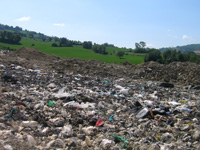
Story by Melissa Traynor
In between cracks in the
rocks and scattered over the flat patches of space, broken glass glitters
in the sun’s rays and aluminum cans and scraps of paper and other
trash cover the beach in Naples, Italy.
While beach goers there must confront heaps of trash, the rest of the
city has also been struggling under the weight of its own waste for the
past few weeks. Due to the closure of major landfills, Napolitans have
had to cope with large amounts of garbage scattered in the streets and
stashed in regular living spaces.

But across the country in Cagli, Italy, residents have found a way to
prevent Naples’ plight. They have been participating in a program
known as raccolta differenziata, which means the separation and recycling
of certain waste materials.
The community of Cagli is home to many receptacles for waste removal,
including recycling bins specified for glass, paper, and plastic. Natura
is the waste removal company that holds a contract with the town.
The ultimate goal of raccolta differenziata, according to Gino Traversini,
head of Cagli’s Comunita Montana, a government coalition of five
towns, is to lessen the amount of waste deposited into surrounding landfills.
The local landfill, Ca’ Guglielmo, has been operating since 1988
and accommodates about 17,000 metric tons per year.
“Every landfill has a certain lifetime and we wanted to take less
stuff to the landfill to make it last longer. The only way to do that
was raccolta differenziata,” Traversini says.
He adds that the successful separation of recycling materials has decreased
volume in landfills by 60 percent to 70 percent. The Cagliese have bought
themselves time to prevent such crises as the one in Naples by reducing
the overall amount of garbage dumped into landfills.
Two branches of Comunita’ Montana, including the one that Cagli
belongs to, joined together in 1994 to create a public entity to manage
waste disposal and landfill operations, Traversini explains.
Before 1994, each municipality managed its own landfill. The new system
has led to better management and more control over landfills so that waste
regulations are obeyed.

Ca’ Guglielmo has one and a half to two years of life left and operates
under strict management. Maurizio Brunore, an employee at the landfill,
says that they practice an advanced degree of recycling. When trash is
piled into the earth, it emits propane gas. A system is installed at the
landfill that collects the gas so that it can be sent out to electricity-generating
plants and burned for power.
Air and water measurement stations are scattered throughout the landfill
so that employees can check to see if the groundwater is potable and whether
the air is clean. These stations are fairly expensive, Brunore says, “but
this is something that has to be done.”
“In Northern Italy they’re doing very well with waste removal.
[Central Italy] is in between and moving toward the model of the North.
The plague exists in the South where 0.01 percent of waste is recycled,
meaning recycling practically doesn’t exist,” Brunore says.

“Down there, they have bribes and the mafia is involved,”
Brunore says about the situation in Naples. “After drug trafficking,
the garbage industry is the biggest money maker for organized crime.”
In Cagli, the citizens pay a tariff for the waste removal service. The
bill, which is calculated and distributed by Natura, reflects the number
of people in a household for a family and the activities of a business.
For example, a grocery store that turns out many boxes and crates will
pay a larger sum than a lawyer’s office. Traversini says that the
average family pays approximately 300 to 400 euro per year. Cagli and
Piobbico are the only ones out of five towns in their Comunita’
Montana that use the tariff system.
The remaining three towns abide by a tax system that bases the cost on
square footage of a building. For every 100 square meters, a property
owner pays 180 euro, including tax.
Since Cagli switched from the old system, “some people pay more
and others pay less than before,” Traversini notes. “It’s
more fair,” he says,” but then again, the people are always
complaining.”
Vellecha, a woman who tends to the meats and fresh produce at the Sidis
grocery store in Cagli, says the store is required by the Comunita’
Montana to practice some degree of raccolta differenziata.
“We have to separate plastic and paper from ordinary garbage,”
she says. “Natura sends out a truck to pick up our trash that drives
out specifically to the store,” she said.
Traversini says he was pleased with the amount of cooperation by citizens.
“Here we’re getting a good response from the people,”
he says.
Receptacles placed for specific groups of families have increased the
rate of raccolta differenziata, he says, and houses on the edge of town
with larger gardens are beginning to develop compost piles for organic
items.
“We provide these
services, but the real challenge is to raise consciousness about the importance
of taking care of the environment,” Traversini says. “I was
recently gratified when I saw a 10-year-old reproach an adult for throwing
paper on the ground.”
Video by Lea Faminiano
Photos by Katie Koepfinger
Web Design by Kate Lacey |

